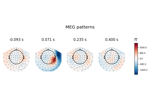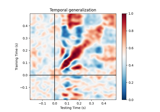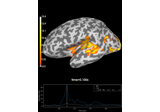mne.decoding.LinearModel¶
- class mne.decoding.LinearModel(model=None)[source]¶
Compute and store patterns from linear models.
The linear model coefficients (filters) are used to extract discriminant neural sources from the measured data. This class computes the corresponding patterns of these linear filters to make them more interpretable 1.
- Parameters
- modelobject |
None A linear model from scikit-learn with a fit method that updates a
coef_attribute. If None the model will be LogisticRegression.
- modelobject |
Notes
New in version 0.10.
References
- 1
Stefan Haufe, Frank Meinecke, Kai Görgen, Sven Dähne, John-Dylan Haynes, Benjamin Blankertz, and Felix Bießmann. On the interpretation of weight vectors of linear models in multivariate neuroimaging. NeuroImage, 87:96–110, 2014. doi:10.1016/j.neuroimage.2013.10.067.
- Attributes
Methods
__hash__(/)Return hash(self).
Compute distance from the decision function of y from X.
fit(X, y, **fit_params)Estimate the coefficients of the linear model.
fit_transform(X, y)Fit the data and transform it using the linear model.
get_params([deep])Get parameters for this estimator.
predict(X)Compute predictions of y from X.
Compute probabilistic predictions of y from X.
score(X, y)Score the linear model computed on the given test data.
set_params(**params)Set the parameters of this estimator.
transform(X)Transform the data using the linear model.
- fit(X, y, **fit_params)[source]¶
Estimate the coefficients of the linear model.
Save the coefficients in the attribute
filters_and computes the attributepatterns_.- Parameters
- Returns
- selfinstance of
LinearModel Returns the modified instance.
- selfinstance of
Examples using
fit:
- set_params(**params)[source]¶
Set the parameters of this estimator.
The method works on simple estimators as well as on nested objects (such as pipelines). The latter have parameters of the form
<component>__<parameter>so that it’s possible to update each component of a nested object.- Parameters
- **params
dict Parameters.
- **params
- Returns
- instinstance
The object.


